
Ace_the_IELTS
.pdf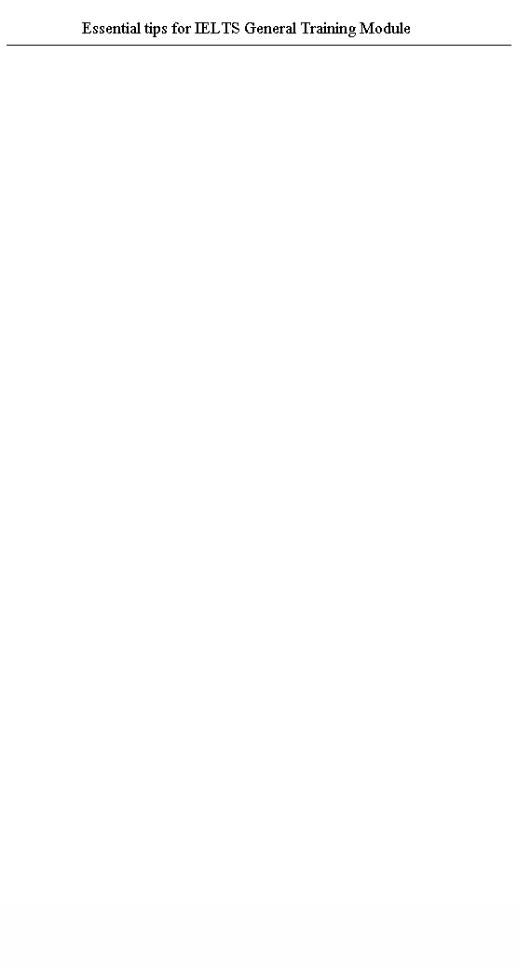
Instructions will keep you safe
Every task in IELTS Listening test has its instructions. It may sound stupid, but you really need to read them carefully. Why? Because they will tell you exactly what to do with the information: how many words you can use to answer, is there a table you must fill, is there a list to chose words from, how many items you must name, etc.
And if the answer must be in 3 words – write EXACTLY 3 WORDS, because writing four or two words will get you 0 score.
To make my point crystal clear, let’s take the following scenario for example: The speaker on a tape says:
“Well, if you are dieting, try to avoid fruits with lots of fructose like watermelon, mango, peaches or grapes.”
The question in the booklet is:
“Name 2 fruits a person on a diet should not eat”.
The answer may be “watermelon, mango” or “mango, peaches” or any combination of two items, but never three or four!!! Anyone who writes “just in case” – watermelon, mango, peaches, grapes – receives 0 score for that question.
Note: when counting words – “a” or “the” counts as a word.
Divide and concur!
The recording divides questions into groups, so every time you are instructed to answer a group of 4-5 questions. There are 20-30 seconds of silence before each group.
First thing you should do when the tape starts playing, is understand which group of questions you need to answer.
For example the tape says: “Look at questions one to four”. It means that you have about 20 seconds to look at those questions. Go over questions, read them and underline keywords. Keywords are words that contain the main idea of the question. They will help you guess what you will hear – numbers, opening hours, names, locations, etc.
Draw a line under question four, so you won’t look further before it’s time.
Then you will hear a piece of passage and answer the questions one to four as you listen. It means that you should be able to write one answer and listen to another.
Page 10
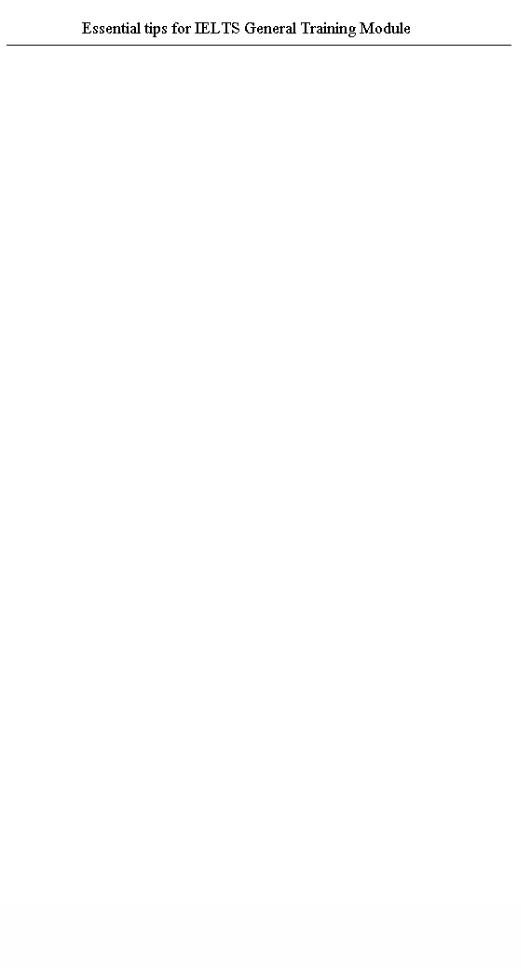
After that, the tape will say the numbers of questions in the next group. Repeat the same process, including drawing the line. This dividing technique is very efficient because every time you concentrate on limited number of questions, so it makes you more focused and in control.
Distractions
Don't get confused by all the different voices you are going to hear. The recording uses several different voices – of younger and older people, men and women. You may also hear different accents - Australian, British, American, Japanese, etc. The background noise is also varies. It can be of airport, cafe-shop, street, University lecture hall, you name it. Be ready for it and don't let it distract you – because that is exactly what they want. Ignore the noises and listen for the answers.
Listen for specifics
When you are listening, look for descriptions and details, such as dates, places, telephone numbers, opening hours, years (1995), transportation (car, bike, train)
If you hear them, but don’t know where to place them yet – write them on margins of the Listening booklet. Later you will have some time to check your answers. Going over the questions that you couldn’t answer during the Listening passage, you might see that what you’ve written on the margins fits.
Answer as you listen
The reason you have to “answer as you listen” is that you immediately forget the sentences after you have heard them – because of stress, foreign language, constant flow of information, etc. After hearing the third sentence you won’t be able to repeat the first. It means that when any part of Listening is over – you won‘t be able to remember any of the answers. So write them as you hear them, leave nothing for later.
Keep moving forward
A worst case scenario is you “loosing the sequence of answers” – so you miss one answer and then you miss another one and so on. To prevent that from happening, always look one or two questions ahead. It sounds confusing, but after a little practice becomes very natural and helps a lot. Even if you have missed the answer to a question – admit it and move to the next one, otherwise you will loose it too.
Page 11
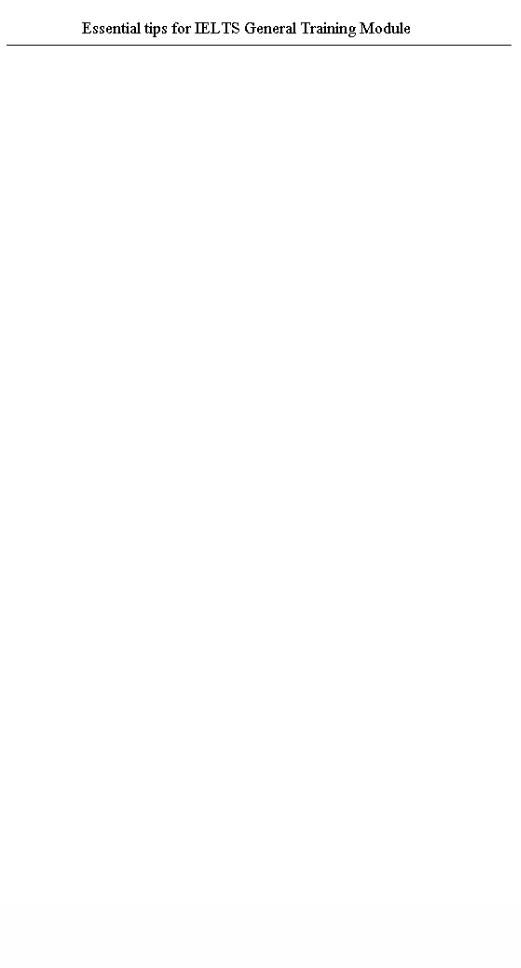
Know your clues
The answer is usually pronounced louder and clearer, it is easier to hear and understand. If you can’t hear something clear (because the speaker swallows words or whispers), then probably the answer is not there. With some practice you will be able to tell the difference.
A good clue to answer is when you hear a repetition of a word, a word being spelled out (G A R F U N K E L) or a number dictated.
Spelling tasks
As simple as it sounds, the spelling task is not so easy. You should practice a little to be prepared for it. Just ask someone to spell the names of cities from the following list for you. If you study alone, you could record yourself spell those names and numbers, and then play it. The same goes for the list of telephone numbers I include here. It is a good practice and will only add to your confidence. Note: in numbers "00" sometimes is read as “double o” instead of “zero-zero”.
Cities |
Numbers |
Antananarivo |
423-5207-0074 |
Brazzaville |
628-2087-2311 |
Conakry |
5167-832-0155 |
Gaborone |
8746-221-0302 |
Johannesburg |
5337-298-0132 |
Kinshasa |
5900-231-7621 |
Libreville |
4348-663-980 |
Lilongwe |
11-267-55410 |
Mogadiscio |
101-9020-7624 |
Ouagadougou |
413-2567-9011 |
Windhoek |
782-6721-0412 |
Islamabad |
479-2001-6792 |
Rangoon |
821-6283-1382 |
Ascension |
492-5241-8921 |
Vancouver |
941-2042-9142 |
Al Minuya |
871-5466-0098 |
Qandahar |
917-5422-3333 |
Jharkhand |
244-1449-2100 |
Page 12
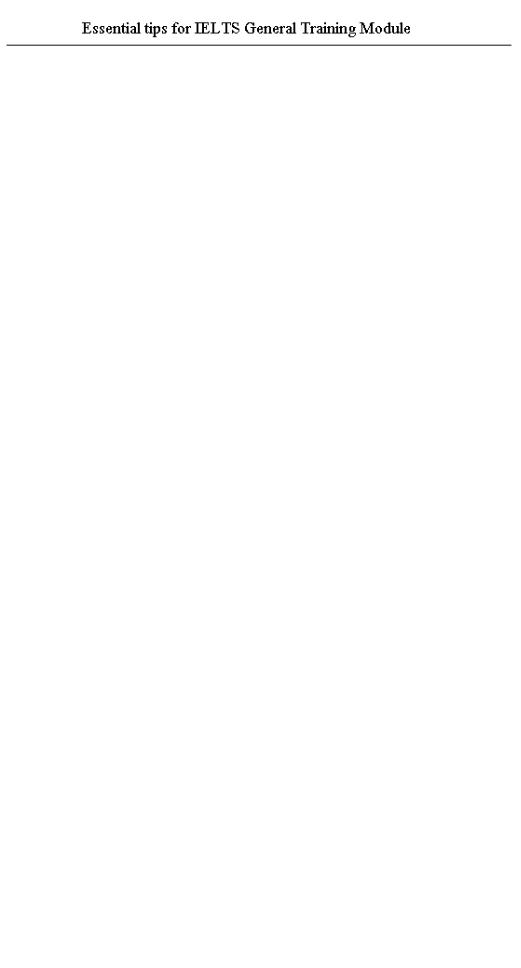
Typical Listening tasks
Remember my promise – no surprises in IELTS? The following table shows you every type of task you may see in the Listening test booklet. Different task types come with different instructions, so if you see and remember them now, it will save you time later.
Of course, you won't get every type I show here in your test and the table looks a bit boring. Anyway, my advice is to get to know them now.
Don’t let them catch you off-guard!
Task Type |
|
What do you do |
Instructions in the |
|
|
|||||
|
|
|
|
booklet |
|
|
|
|
|
|
|
|
|
||||||||
Picking pictures |
From 3-4 pictures choose a picture that |
Circle the appropriate letter |
||||||||
|
|
|
best describes what you hear on tape |
|
|
|
|
|
|
|
Multiple |
choice |
There is a question and a number of |
Circle the appropriate letter |
|||||||
questions |
|
answers (three, four or five), your job is to |
/Circle the correct answer |
|||||||
|
|
|
pick the right one (sometimes more than |
|
|
|
|
|
|
|
|
|
|
just one). |
|
|
|
|
|
|
|
|
|
|
|
|
|
|||||
Short-answer |
|
Answer in 3 words, as the instructions say |
Complete |
the |
notes/table. |
|||||
question |
|
|
Use NO MORE THAN 3 |
|||||||
|
|
|
|
WORDS for each answer |
||||||
Sentence completion |
Complete a sentence according to what |
Complete |
the |
notes/table. |
||||||
|
|
|
you hear |
Use NO MORE THAN 3 |
||||||
|
|
|
|
WORDS for each answer |
||||||
Form completion |
A form is given and you need to fill in |
Complete |
the |
form. Write |
||||||
|
|
|
blank fields |
NO |
MORE |
THAN |
3 |
|||
|
|
|
|
WORDS for each answer |
||||||
Chart/Table |
|
A table with some blank cells is given; |
Complete |
the |
notes/table. |
|||||
completion |
|
your job is to fill them according to the |
Use NO MORE THAN 3 |
|||||||
|
|
|
passage you hear. |
WORDS for each answer |
||||||
|
|
|
|
|
||||||
True/False/Not Given |
A statement, which is either True, False or |
Complete |
the |
notes/table. |
||||||
task |
|
Not Given in the passage, you need to |
Use NO MORE THAN 3 |
|||||||
|
|
|
decide according to what you hear |
WORDS for each answer |
||||||
Gap-fill |
|
There are several sentences with missing |
Complete the notes |
below |
||||||
|
|
|
words, you should pick the correct word |
by |
writing |
NO |
MORE |
|||
|
|
|
and fill it in the gap. Choose from the list |
THAN 3 WORDS in the |
||||||
|
|
|
(if there is one), or from what you have |
spaces provided |
|
|
||||
|
|
|
heard. |
|
|
|
|
|
|
|
Diagram labeling |
Write description in 1 to 3 words for |
Complete/label |
|
the |
||||||
|
|
|
different parts of a drawing according to |
diagram |
by |
writing |
NO |
|||
|
|
|
what you hear |
MORE THAN 3 WORDS |
||||||
|
|
|
|
in |
the |
|
boxes/spaces |
|||
|
|
|
|
provided |
|
|
|
|
|
|
|
|
|
Page 13 |
|
|
|
|
|
|
|
|
|
|
|
|
|
|
|
|
|
|
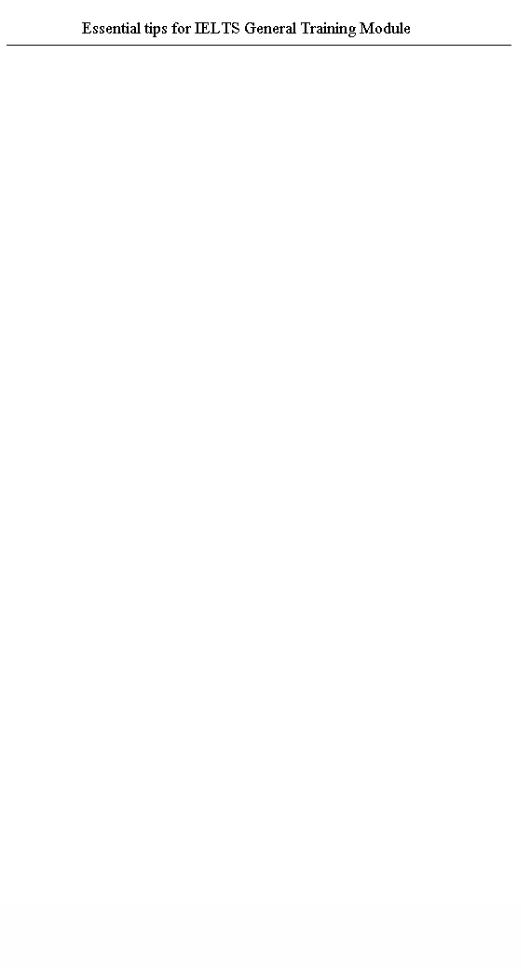
Eliminate
When you deal with multiple-choice questions, elimination is a good strategy. Usually only one answer is correct, unless instructions say something else.
This task is similar to True/False/Not Given. You should decide for every choice of answer - is it True, False or Not Given in the passage. After you have decided, choose the one that is True – this is the correct answer. Any other choice, False or Not Given, is incorrect.
Keep in mind that there are cases when all the choices are correct or none of them is correct. Read the instruction carefully and you will know what to do in such cases.
Gap-fill strategy
Look at the words around the gap to understand what’s missing, a noun (like boy, toy, truck), an adjective (little, pretty, shiny) or a verb (stands, looks, moves).
For instance, if you see Noun before the blank (“The boy is___”), it means that it’s Adjective (“The boy is small”) or it’s Verb (“The boy is smiling”) is missing.
Once you have picked a word, write it above the gap and then read the whole sentence to be sure that it makes sense.
"Chameleon" questions
They might use different words with the same meaning to confuse you. It could be expressions or synonyms.
For example, the tape says “All the candidates have to fill an application form” and the question says “The candidates must fill an application” – is it True, False or Not Given? The correct answer is True because "have to" means "must".
Page 14
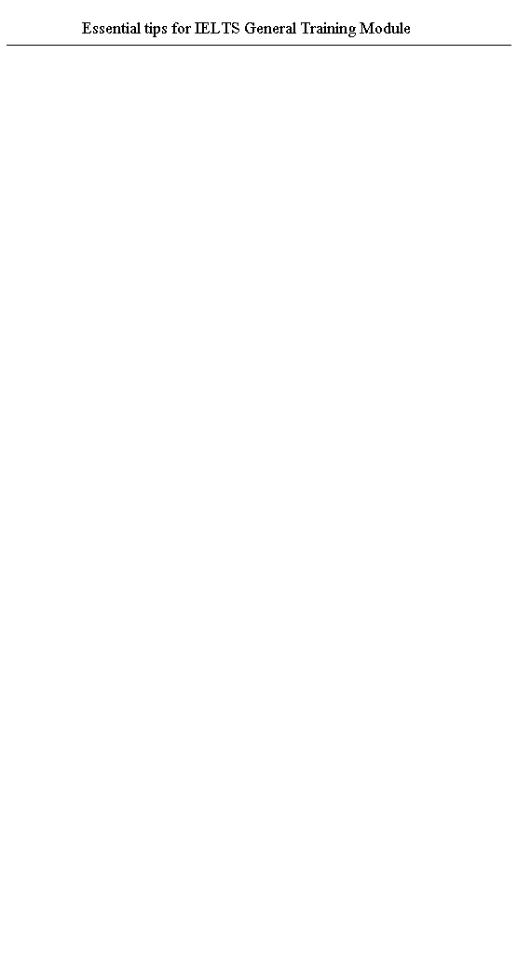
Watch out for traps
Trap Number One – unexpected turn
You might hear speaker starting to say one thing and then, suddenly, continuing to something completely different. This is a trap, so make sure you don’t fall for it. The rule here is “Last word counts”. For example, if the speaker says “I want to visit that gallery on Monday. No, wait, I’ve just remembered that it is closed on Monday, so I will go on Wednesday.”, and the question is “when” – the correct answer here is Wednesday, and Monday is a trap.
Trap Number Two – generalizations
You might hear speaker first gives a list of things and then says them all in one word. For example: “Well, I like to swim, hike, and camp – to be involved in outdoor activities.” If the question is “What kind of activities…” the correct answer is “outdoor” and not “swimming”, “hiking” or “camping”.
Trap Number Three – explicit answer choices
Explicit answers choices can be (and mostly will be) traps. The following example demonstrates what I mean:
The tape says: “This course is a must for all first year students, excluding foreign students”.
The Question is “All the first year students have to take this course”,
The Answer should be F(alse), because there is an exception – foreign students. All the explicit answers that mean “no exceptions” are suspicious to us and call for more attention.
Check the grammar
If the answer you give is grammatically incorrect – it can not be the right one. Checking the grammar of your answers will give you an idea whether your answer correct or not, especially in tasks like:
•Gap-fill
•Sentence completion
Use your time wisely
During the test, you have a little time between passages. Use it to check and complete
your |
answers |
|
Page 15 |
|
|
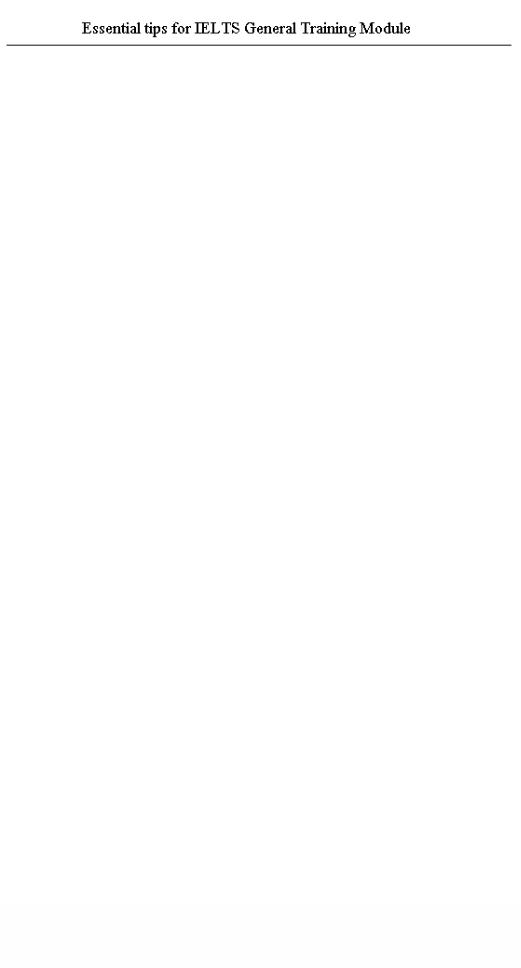
Copy answers smartly
After 20 minutes of Listening test, there are 10 additional minutes. During the test you have written all of the answers in the Listening test booklet. These 10 minutes are given you to copy your answers to the Answering sheet, and you should use them smartly.
The Answer Sheet has 2 sides, one for Reading test and one for Listening test, so make sure you are writing on the Listening side. I include here an example of Answering Sheet so you could get familiar with it and use it for practicing.
First, copy all the answers from the booklet to the Answering Sheet, and pay attention to the following guidelines (as simple as they sound – they are BIG time savers):
•For multiple-choice questions and picking pictures - just copy the letter of correct answer, don't circle it.
•For sentence completion – just copy your answer, not the whole sentence.
•For True/False/Not given question – just copy T, F or NG, whatever your choice is.
•For gap-fills – just copy the word you have chosen for the gap.
•For answers written in short (like prof. advise) – write the full version (professional advise).
•Check that all the answers are clear and understandable.
Now, if you missed some questions – it is a good time to guess.
Page 16
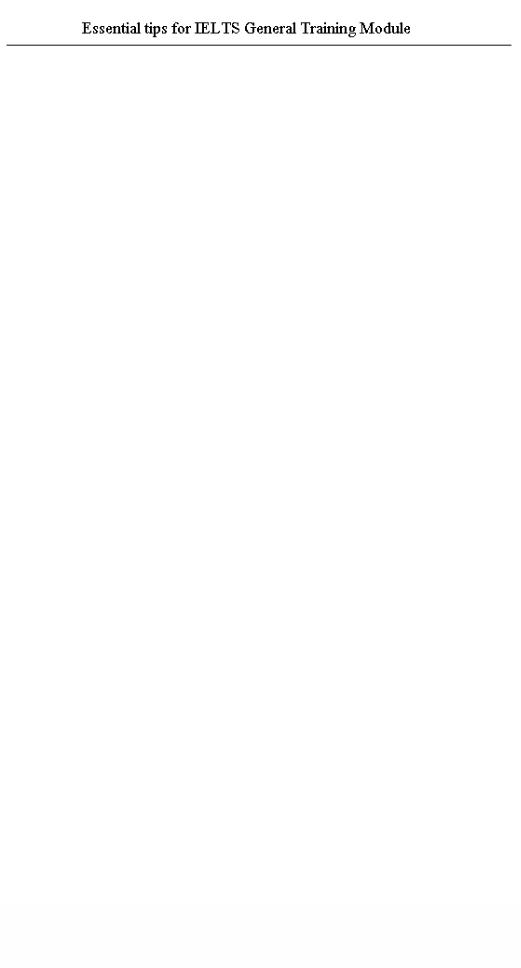
Answering Sheet looks like this:
1 |
|
22 |
|
2 |
|
23 |
|
3 |
|
24 |
|
4 |
|
25 |
|
5 |
|
26 |
|
6 |
|
27 |
|
7 |
|
28 |
|
8 |
|
29 |
|
9 |
|
30 |
|
10 |
|
31 |
|
11 |
|
32 |
|
12 |
|
33 |
|
13 |
|
34 |
|
14 |
|
35 |
|
15 |
|
36 |
|
16 |
|
37 |
|
17 |
|
38 |
|
18 |
|
39 |
|
19 |
|
40 |
|
20 |
|
41 |
|
21 |
|
42 |
|
For those of you who wonder why all the answers have to consist of maximum 3 words – here is the answer: there is not enough space on the Answer Sheet for anything longer than that!
Practice, practice, practice!
I strongly recommend that you use all the tips while practicing. In order to practice you are going to need samples of Listening test, which can be found on the following internet sites (good quality, free of charge):
http://elc.polyu.edu.hk/IELTS/ - take it online, or print the booklet http://www.esl-lab.com/ - for this one you will need Real Audio Player http://www.international.holmesglen.vic.edu.au - download the sample, print booklet http://esl.about.com/cs/toefl/a/a_ielts_2.htm
Play the Listening samples and start using the tips while searching for answers. This is the only way to really understand how these tips work. You may have to play the same Listening file more than once, to practice in different techniques.
Page 17
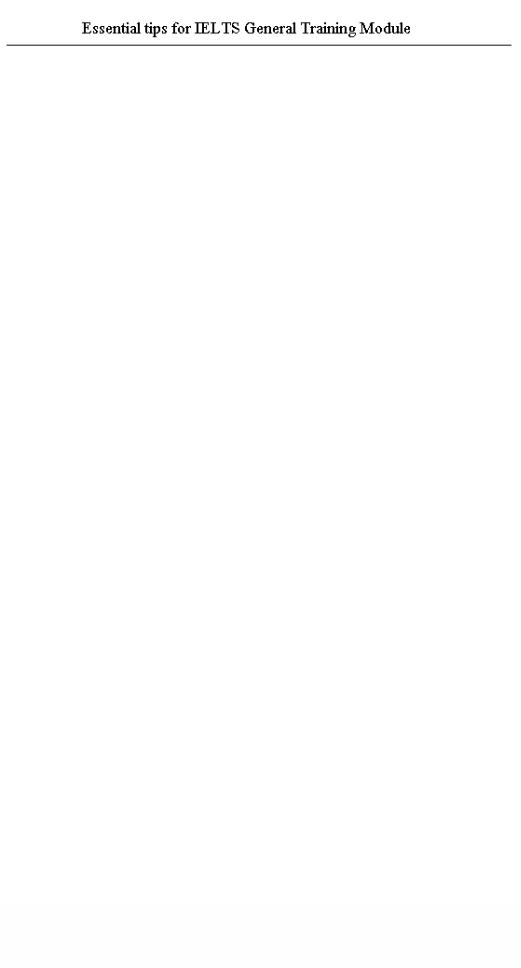
Tips for the Reading Test
Test structure
The structure of Academic and General Training Reading tests is different. Academic Reading on most cases consists of 3 large texts from newspapers or magazines. In General Training there are several smaller passages that are taken from advertisements, official documents, booklets, manuals and 2 or 3 larger texts taken from books, magazines or newspapers.
Like in the Listening test, questions in the Reading test are given in groups. Instructions will tell you which group of questions belongs to which paragraph or portion of text. You may see the questions before or after the passage they belong to.
Manage your own time
As I said before, time is your greatest enemy. In the Listening test it was managed for you, but not in the Reading test. So manage it very carefully yourself.
When you receive the Reading booklet, first of all count how many passages are there. Let’s say there are 4 passages in the booklet. It means that you have 15 minutes for each passage. Write the time when you should start and when you should end working on each passage and stick to it. Use 13 minutes to actually answer the questions (write the answers on the booklet pages) and 2 to copy your answers to the Answer Sheet. If you didn’t finish a passage on time, move to the next one anyway. And whatever you do, please do not forget about the Answering Sheet (remember the guy with the ZERO score?)
If you have some time left in the end of Reading test, make sure that you didn’t forget to answer any question, check and double check your answers. It can add you a few “easy” points if you find mistakes before the examiner does ☺.
Don’t read – scan!
It sounds absurd that you don’t need to read on a Reading test, right?
Anyway, it’s true. The biggest mistake you could make is to start the test by reading the whole passage.
The best thing is to scan quickly through the text. Don't try to understand every word! Just go over it and get the idea of what each paragraph is about. Usually you don't need to read the whole paragraph – a couple of first sentences are enough.
Page 18
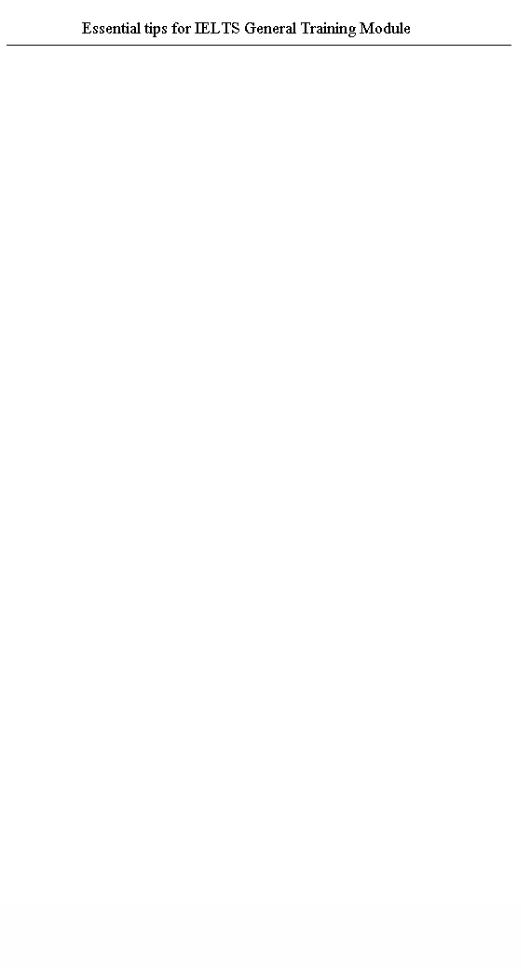
Make a map
The text before you is like a new strange territory, it is easy to get lost inside all these words. What you need is a map that will help you to orientate. Every paragraph in the passage has its own main idea, different from all other paragraphs. Write on the margins near the paragraph what is its topic, main idea. If writing takes too much time, underline the words in the paragraph that explain its main idea. Congratulations! You have just created a map that later will guide you through the search for answers.
Learn the rules
First, read instruction and example. They show you exactly how your answer should look like – is it a number or a name, how many words you must write, etc. The following points are important because they may affect your score.
1.Style
When filling the answers, copy example’s style. For demonstration look at the following table:
|
USA |
Canada |
Sweden |
Divorces rate |
Example 1: 55% |
|
|
Marriage |
Example 2: first |
|
|
Example 1
If the example says “55%”, give your answer in this exact form, a number and %. Any other form or style (like “55” or “55 percent” or “fifty five percent”) may harm your score!
Example 2
If the example says “first”, answering in any other form or style (like “1st”, “1” or “first marriage”) may harm your score.
2.Words Limit
Usually if there is a word limit for answer, it is no more than 3 words. Prepositions (in, of, to, at, etc) and articles (a, an, the) do count for a word. The reason behind this 3 word limit is small space on the Answer Sheet.
3. One question – one answer
Don’t give more than one answer to one question, even if you see more than one option. It will result in ZERO score. For example, if you see in a passage names of 3 countries that qualify as an answer and the question asks to name just one – don’t even think of giving 2 or 3 names, the only correct answer is to name exactly one. Only if they ask for two names, you should name two, etc.
Page 19
